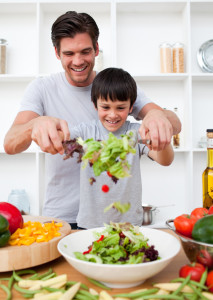 A healthy diet and exercise program will help children to grow and have more energy. Families should strive to eat the proper amount of nutritious foods daily. These foods have many positive effects on the body. Did you know that tomatoes, spinach, and garlic may help the body to fight infections? Home cooked meals are more nutritious, have fewer calories and fat than going out to eat. You should also try to eat fresh and not processed foods.
A healthy diet and exercise program will help children to grow and have more energy. Families should strive to eat the proper amount of nutritious foods daily. These foods have many positive effects on the body. Did you know that tomatoes, spinach, and garlic may help the body to fight infections? Home cooked meals are more nutritious, have fewer calories and fat than going out to eat. You should also try to eat fresh and not processed foods.
In today’s faced paced society, however, children are eating out much more often than they did years ago. According to the Centers for Disease Control, 12.1% of children in the United States obtain more than 40% of their daily calories from fast food restaurants. Childhood obesity has risen from 7% in 1980 to 18% in 2012. Children who do not exercise and eat a healthy diet can have the same health risks as adults. Health risks of childhood obesity include: high blood pressure, high cholesterol, diabetes and cardiovascular disease. In this article, we will discuss how to help children make better lifestyle choices.
Children are like sponges and will learn everything a parent teaches them. This is also very true with diet and exercise, as well. It is important for parents and caregivers to adopt healthy habits when it comes to lifestyle choices. If children are used to eating healthy they will usually choose to eat healthy foods when they are hungry.
Diet and exercise should be fun and can be made into an entire family activity. In fact, it is important that children help to select foods and prepare snacks. It will be fun and they will be much more eager to try something they helped to make. By using bright colored fruits and vegetables to make healthy eating fun, you can for example, make avocado boats, smiley faces with a fruit tray, or even banana roll ups for a nutritious snack.
An important tool for some families is “Traffic Light Eating.” Think of a traffic light which has a green, yellow and red light. When applied to selecting foods, the green light means “go” which means you can eat as much of these foods as you like. Yellow means “slow down” and red means “stop and think.” All fruits and vegetables would be in the green light category. Traffic Light eating can be fun for children to learn as well.
 It is also helpful to give kids a choice in what they are eating. You can give them two or three healthy snack options so they can select foods they like. It is important that children see parents eating the same foods as they do.
It is also helpful to give kids a choice in what they are eating. You can give them two or three healthy snack options so they can select foods they like. It is important that children see parents eating the same foods as they do.
Providing time for physical activity each day is just as important as eating healthy. Set some rules for the time spent watching television and playing video games. Too many children are physically inactive since there is so much technology today. Try to set aside 60 minutes every day for physical activity. For example, your family can take a walk, run, play hop scotch or jump rope.
There are currently many options available for parents to learn about nutrition and physical activity. Fitness facilities and online health coach programs are also popular options. Some gyms offer family or exercise programs specifically for children. Children may learn simple lifting techniques or play games
Making healthy lifestyle choices is very important for children and parents. Think of nutritious food as fuel that your body needs to function properly. Fast food does not provide long lasting energy or foster growth. Over time, your family will start to feel better overall. Below is a healthy recipe that you can try with your children.
WIGGLE WORM KABOBS
Ingredients
- Cherries
- Bite size pieces of melon, strawberries, bananas, and grapes
- Pretzel sticks
Preparation
Spear about four pieces of fruit onto each pretzel and leave a little room at the end of the pretzel. Join two worms with a piece of fruit to make a longer worm!
Robyn Caruso is the Founder of The Stress Management Institute for Health and Fitness Professionals. She has 15 years of experience in medical based fitness.
References
https://www.cdc.gov/healthyschools/obesity/facts.htm
https://medlineplus.gov/childnutrition.html
http://www.cdc.gov/physicalactivity/basics/children/
http://www.huffingtonpost.com/tyler-tervooren/traffic-light-diet_b_7035754.html
